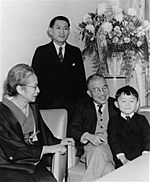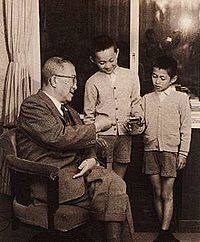Ichirō Hatoyama facts for kids
Quick facts for kids
Ichirō Hatoyama
|
|
|---|---|
|
鳩山 一郎
|
|
 |
|
| Prime Minister of Japan | |
| In office 10 December 1954 – 23 December 1956 |
|
| Monarch | Shōwa |
| Deputy | Mamoru Shigemitsu |
| Preceded by | Shigeru Yoshida |
| Succeeded by | Tanzan Ishibashi |
| Member of the House of Representatives | |
| In office 25 March 1915 – 7 March 1959 |
|
| Preceded by | Masutarō Takagi |
| Succeeded by | Seiichirō Yasui |
| Constituency | Tokyo City |
| Personal details | |
| Born | 1 January 1883 Tokyo City, Empire of Japan |
| Died | 7 March 1959 (aged 76) Bunkyō, Japan |
| Political party | Liberal Democratic (1955–1959) |
| Other political affiliations |
Rikken Seiyūkai (1915–1940) Japan Liberal Party (1945–1948) Democratic Liberal Party (1948–1950) Liberal Party (1950–1953) Liberal Party–Hatoyama (1953) Liberal Party (1953) Japan Democratic Party (1954–1955) |
| Spouse | Kaoru |
| Children | Iichiro Yuriko Reiko Setsuko Keiko Nobuko |
| Signature |  |
Ichirō Hatoyama (鳩山 一郎, Hatoyama Ichirō, 1 January 1883 – 7 March 1959) was an important Japanese politician. He served as the Prime Minister of Japan from 1954 to 1956.
Hatoyama was a conservative leader. He played a big role in joining two political groups, the Liberal Party and the Democratic Party, in 1955. This merger created the Liberal Democratic Party (Japan) (LDP). Hatoyama became the first leader and first prime minister of this new party. The LDP went on to govern Japan for many decades.
As prime minister, one of his biggest achievements was making official diplomatic connections with the Soviet Union again. These connections had been stopped since World War II.
Contents
About Ichirō Hatoyama's Life
Ichirō Hatoyama was born on January 1, 1883, in Tokyo. He came from a rich and well-known family. His father, Kazuo Hatoyama, was a graduate of Yale Law School and even served as the Speaker of the House of Representatives in Japan. His mother, Haruko Hatoyama, was a famous writer and started a women's university.
Ichirō Hatoyama was a Protestant Christian and a member of a group called the Freemasons. He was the third Christian prime minister in Japan after World War II.
Ichirō's only son, Iichirō Hatoyama, also became a public servant. He worked in the Finance Ministry and later became the Foreign Minister of Japan.
One of Ichirō's grandsons, Yukio Hatoyama, followed in his footsteps and became prime minister in 2009.
Ichirō Hatoyama passed away in his home in Tokyo on March 7, 1959. He was buried in the Yanaka Cemetery.
Ichirō Hatoyama's Political Journey
Ichirō Hatoyama was first elected to the House of Representatives in 1915. He continued to serve there until he died in 1959.
He was supposed to become prime minister in 1946. However, after World War II, he was not allowed to be involved in politics for five years. This was because some people believed he had cooperated with the government that was in power during the 1930s and 1940s. Later, this rule was changed, and he was allowed to return to politics in 1951.
Old government files, made public in 2007, showed that there was a plan in 1952 by a group of people to replace Prime Minister Shigeru Yoshida with Ichirō Hatoyama. This plan was never carried out.
As prime minister in 1955, Hatoyama brought back official connections with the Soviet Union. He was a strong conservative. He wanted to give pardons to some people who had been punished after the war by the Tokyo Trial.
He also hoped to change the Japanese Constitution. He wanted to remove Article 9, which says Japan cannot have a military for war. To work on this, he created a "Constitutional Research Commission" in 1956.
That same year, Hatoyama tried to change how elections worked. This plan was called the "Hatomander" (a mix of Hatoyama and Gerrymander). He wanted to change the voting system to make it easier for his party, the LDP, to win more seats. This would have helped them get enough votes to change the Constitution. The plan passed one part of the Japanese parliament, but it was stopped because many people were against it.
The Hatoyama Family and Fraternity
Ichirō Hatoyama and some members of his family were known for supporting the idea of "fraternity." This means a feeling of friendship and support among people. In Japanese, this idea is called yūai (友愛).
During the time when Ichirō was not allowed in politics (1946–1951), he read a book about how a totalitarian state goes against people. This book was written by a Freemason. The book deeply affected Ichirō, and he began to strongly support the idea of fraternity.
On March 29, 1951, he became a member of the Freemasons. He continued to advance in the group, becoming a higher-level member in 1955.
His grandsons, Yukio Hatoyama and Kunio Hatoyama, also support the idea of fraternity. However, it is not clear if Yukio Hatoyama is a Freemason. Kunio Hatoyama mentioned that his partner's father was a Freemason and that he had visited a Masonic pool.
Yukio and Kunio, along with their sister Kazuko Inoue, became leaders of a group called Yūai Kyōkai (or Yūai Association). This group was founded by their grandfather Ichirō in 1953, and he was its first president. Ichirō's son, Iichirō, later became the third president of the same group.
In April 2008, Ichirō's granddaughter and two grandsons started a school called Hatoyama Yuai-Jyuku at Hatoyama Hall. This school teaches about the idea of fraternity.
Honors and Awards
- Grand Cordon of the Order of the Chrysanthemum (1959; given after his death)
See also
 In Spanish: Ichirō Hatoyama para niños
In Spanish: Ichirō Hatoyama para niños
- Hatomander




